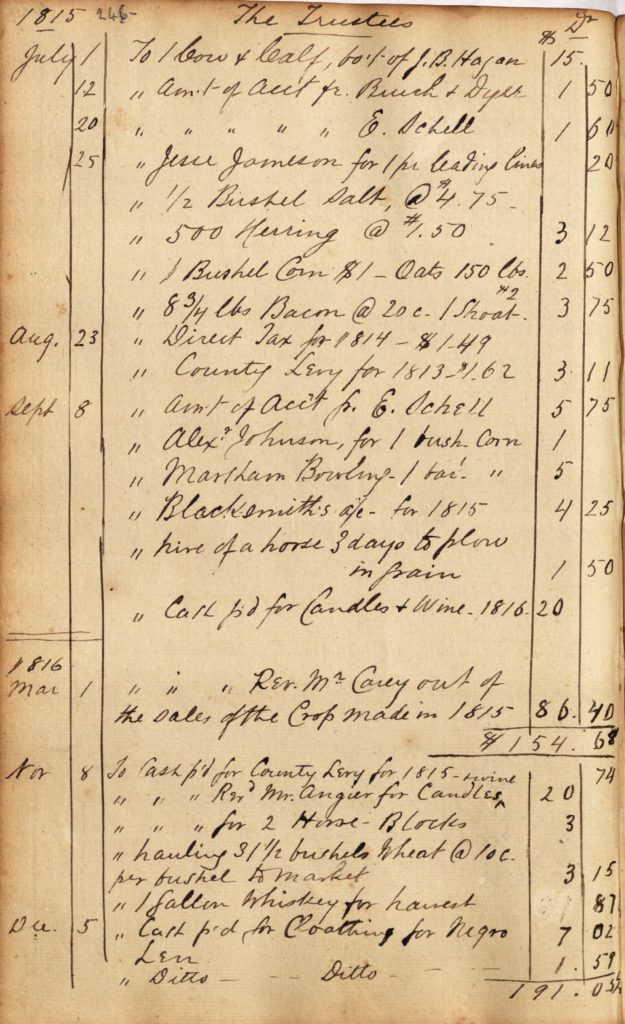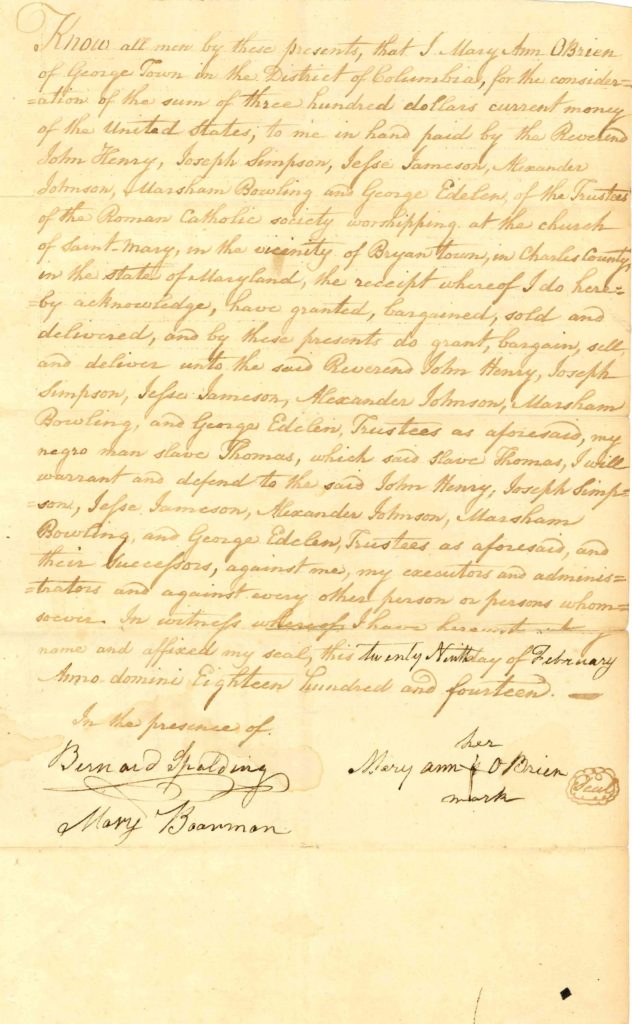Say their names
By Stephanie A.T. Jacobe, Ph.D.
 Tom, Len, Pius, Roger, and Calib. These five men have no family names that we know of, only Christian names. We know all of them lived in the years between 1814 and 1832, because we have written records of them from that period. We also know that they were men who were enslaved and have a unique connection to the Archdiocese of Washington. Each of these men were owned by and labored for our local Catholic Church in Maryland.
Tom, Len, Pius, Roger, and Calib. These five men have no family names that we know of, only Christian names. We know all of them lived in the years between 1814 and 1832, because we have written records of them from that period. We also know that they were men who were enslaved and have a unique connection to the Archdiocese of Washington. Each of these men were owned by and labored for our local Catholic Church in Maryland.
The parish known as “Upper and Lower Zechiah and Mattawoman,” consisted of three separate chapels, two of which still exist today. St. Mary’s Parish in Bryantown traces its history to a private chapel at the Lower Zechiah (or Zekiah) on the estate of William Boarman. The second chapel was on Thomas Reeves’ land on the Upper Zechiah, which later became St. Peter’s Parish in Waldorf. The chapel on the Mattawoman site was located south of the later parish of St. Mary’s in Piscataway and no longer exists.
The Archives of the Archdiocese of Washington holds some of the early records of the parish and all three chapels. This includes sacramental records dating from 1793 to 1873 and the records of the trustees and accounts of the Bryantown Chapel from 1811 to 1842. The records of the parish also document that the parish owned at least three men who were enslaved. Their names are recorded as Thomas or Tom, Len or Leonard, and Pius.
Tom was purchased from Mary Ann O’Brien of Georgetown by the pastor and Trustees of St. Mary’s in Bryantown in 1814. The bill of purchase was copied into the Trustee’s accounts inside the register. The original bill of purchase was sent to the Archdiocese of Baltimore around 1858 and transferred to the Archdiocese of Washington in 1948. It was recently discovered among the land deeds in the Archdiocesan Archives.
 The parish accounts from 1815 to 1827 show that Tom was hired out each year to work on a different neighboring plantation. The plantation owner who hired him would pay the parish a sum of money for his hire. The sums ranged between $40 and over $100 per year. Len shows up in the parish accounts beginning in 1816 when the parish provided him with a new suit of clothes, which may indicate that he had recently been purchased. He was hired out each year like Tom was. The detailed parish account records end in 1829 with the tenure of Jesuit Father James V. Wiseman as pastor. Records relating to both Tom and Len end there as well.
The parish accounts from 1815 to 1827 show that Tom was hired out each year to work on a different neighboring plantation. The plantation owner who hired him would pay the parish a sum of money for his hire. The sums ranged between $40 and over $100 per year. Len shows up in the parish accounts beginning in 1816 when the parish provided him with a new suit of clothes, which may indicate that he had recently been purchased. He was hired out each year like Tom was. The detailed parish account records end in 1829 with the tenure of Jesuit Father James V. Wiseman as pastor. Records relating to both Tom and Len end there as well.
Pius, the last man enslaved by the parish, was identified as the pastor’s house servant. His name appears in the sacramental register serving as a stand-in baptismal sponsor for several children beginning in 1827. The baptism of Pius’s own son, John Henry, is also recorded in the register on Jan. 4, 1832. His son’s mother was Emilia, a woman enslaved on the Boarman estate, which was located directly adjacent to St. Mary’s in Bryantown. We know that Pius served both Father Wiseman (1825-1829) and Father Francis Roloff, a priest of Baltimore (1829-1842) when each was pastor.
Pius was originally from the Upper Zechiah portion of the parish. When Thomas Reeves died in 1825, he willed his plantation, with the house chapel used for the Upper Zechiah portion of the parish, to Archbishop Ambrose Marechal of Baltimore. In addition to the house, chapel, farm, and land, he gave the archbishop three men who were enslaved, Roger, Calib, and Pius. We know that Pius became the personal servant of the pastor, but we have no further records of Roger or Calib.
 Later records of St. Peter in Waldorf suggest that the parish continued to work Thomas Reeves’ farm for income well into the 20th century. In fact, the Archdiocese of Washington still owns nearly 300 acres of Reeves’ original plantation. It is likely that Roger and Calib were tasked at least at the beginning with keeping this farm going as income for the northern part of the parish. When the Upper and Lower Zechiah chapels were separated around 1850, we know that the Reeves farm was in disarray, and there was no sign of Roger or Calib. It had been 25 years since our last record of them, so both men may have died. We also don’t know what happened to Tom, Len or Pius. Records of all three men end by 1832.
Later records of St. Peter in Waldorf suggest that the parish continued to work Thomas Reeves’ farm for income well into the 20th century. In fact, the Archdiocese of Washington still owns nearly 300 acres of Reeves’ original plantation. It is likely that Roger and Calib were tasked at least at the beginning with keeping this farm going as income for the northern part of the parish. When the Upper and Lower Zechiah chapels were separated around 1850, we know that the Reeves farm was in disarray, and there was no sign of Roger or Calib. It had been 25 years since our last record of them, so both men may have died. We also don’t know what happened to Tom, Len or Pius. Records of all three men end by 1832.
Though we don’t know what became of Tom, Len, Pius, Roger, Calib or their families, it is important for us to remember them, their connection to our local Church, and their Catholic faith. It is also imperative that we remember that our local Church participated in and benefited from America’s “Original Sin of racism” (USCCB, Open Wide Our Hearts, pg 6) by owning persons who were enslaved. We must also use our knowledge of our history to continue to advocate for an end to not only personal acts of racism but also systematic racism.
(Dr. Jacobe is the director of Archives for the Archdiocese of Washington.)
